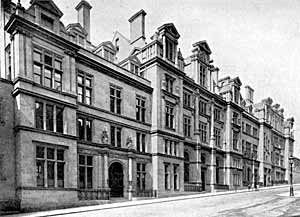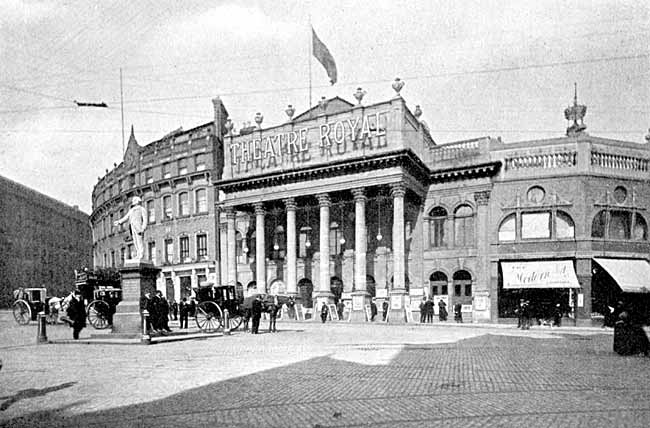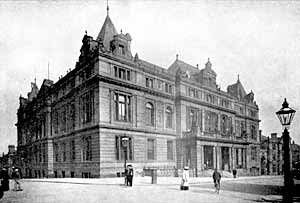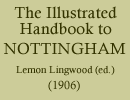< Previous | Contents | Next >
Chapter II.
A walk round Nottingham, Part I.
"CAN it be true," says our visitor, "that Nottingham has a population of over 240,000; the public buildings look so clean and fresh, unlike the dingy, smoke-stained edifices of the great manufacturing towns of the North?" True it is, nevertheless, for Lace and Hosiery Manufactures, the staple industries of the city, are not dirty trades, and besides, the factories, where these fabrics are made, are chiefly situated in the suburbs, especially the Radford and Basford districts, or even outside the town as at Beeston and Long Eaton.
The Market Place.
No matter by what route the traveller has arrived, he will in all probability, ere long, find himself in the Great Market Place. We say advisedly "Great," for is it not 5½ acres in extent? and we have yet to learn where a larger is to be found. Great Yarmouth Market, also famous for its size, is said to measure only three acres. And if Nottingham Market Place is a sight worth seeing in its emptiness, Picture, Reader, what the prospect must be when, on Wednesdays and Saturdays, the wide, open space is filled from end to end with old-fashioned, picturesque canvas-topped stalls, for the sale of all kinds of merchandise. Its "Maddest, Merriest Day," however, is at GOOSE FAIR TIME (October), when it is thronged to its utmost capacity with shows, roundabouts, and gingerbread stalls, to the accompaniment of most excruciating, ear-piercing shrieks of music. Everything in Nottingham dates from "The Fair," not from January 1st. Who has not heard of the Goose Fair? It is said to be the largest in England. So great are its delights that we invite our friends to visit us in order that they may see it. Our children are brought up in the tradition that it is our greatest glory.
Electric Tramways.
Nottingham possesses an admirable Tramway Service, managed by the Corporation. The first line to be constructed was the Sherwood one, and was opened for traffic in 1901. Other lines followed in rapid succession until almost all parts of the town were provided with this means of communication.
Let the visitor survey the Market Place from the bottom of Market Street. Here is the Tramway Centre and Crossing of the principal lines, and at first one is struck with bewilderment at the rapid succession of cars and the variety of their destinations as indicated on the front and sides.
Long Row.
Like Chester and Yarmouth, Nottingham also can boast of its "Rows." The long side of the Market Place, where we have planted our visitor, is known as "Long Row." Here are some of the principal shops, the projecting upper storeys of which form an open colonnade, invaluable on rainy days. On fine Saturday mornings the wide pavement is thronged by a gaily-dressed crowd. It is quite the thing with Nottingham aristocracy to "do" the Row on Saturdays. As the direction of the Row is east and west, it follows that it has a warm and sunny exposure to the south, and even in cold weather it is often a pleasant promenade. The other "Rows" have not the importance of Long Row, and might by comparison be called "Short." In point of fact, however, they are named "Smithy Row," opposite the eastern end of "Long Row"; "Angel Row," facing Long Row towards the west; and "Spaniel Row," out of Friar Lane.
Queen Victoria's Statue.
The Tramways running south from Market Street divide the Market Place into two unequal portions, one an oblong square wherein the principal Market is held, and the other a triangle known locally as the "Pot Market." In the Pot Market stands the handsome colossal STATUE OF QUEEN VICTORIA, erected in 1905 by public subscription, and unveiled by the Duchess of Portland. It is the work of Mr. Albert Toft, A.R.A., and will be seen to be a truly majestic figure and a correct portrayal of the Great Queen. On the sides of the pedestal supporting the statue are bronze panels of emblematic design carrying figures in high relief (representing "Maternity"; "Feeding the Hungry"; "Clothing the Naked"; the fourth panel bearing a shield with the words, "Victoria, Queen-Empress, 1837-1901 ").
The Exchange.
The large, plain, solid-looking building occupying the whole of one side of the Market Place is the EXCHANGE. The ground floor of the frontage is occupied by shops. Near the roof, below the figure of "Justice," is the Clock by which Nottingham people learn the time of day. After dark the hours and minutes are signalled forth by electric glow-lamps, arranged to form the figures. In the interior of the Exchange is a commodious Chamber, in which the Town Council meets. The style of this is "Georgian," and it is lit from the roof. Long, long ago, before Town Councillors led the staid, irreproachable lives which are usual nowadays, there used to be a secret communication between the Chamber and the ancient "Feathers Inn" underneath. The virtue of the modern Councillor is fortified by rigid closing of this avenue of temptation. The large Hall is frequently lent by the Mayor for the purpose of Public Meetings. In the same building are a Committee Room and Mayor's Parlour.
Behind the Exchange is the Meat Market, consisting of Butchers' Stalls of uniform antique pattern. In a house on the south side of the Meat Market was born HENRY KIRKE WHITE, the Nottingham Poet. The house is now "licensed," and displays the poet's portrait as a sign-board.
Bromley House.
On Angel Row may be seen a quaint, old-fashioned house of eighteenth century style. This, once a family residence, is now a SUBSCRIPTION LIBRARY. It contains a splendid collection of books, and the shares were not long ago in great demand. Owing to the formation of numerous other libraries, Bromley House is not so popular as it used to be; it is an ideal spot for a quiet "read," and can boast the advantage of being select, Many of the old brick houses of this end of the Market Place bear traces of having formerly been well-to:do mansions, but by degrees they have almost all become business premises.
Public Buildings.
Opening on to Long Row, near the Exchange, is a wide modern street with handsome buildings on either side. This is King Street, which immediately divides like the arms of the letter Y, the right branch continuing as KING STREET, while the left takes the name of QUEEN STREET. Fronting the spectator, in the interval between the two branches, are the imposing offices of the Prudential Insurance Company, built of ornamental terra-cotta, from designs of the late Mr. Waterhouse, R.A. In front of the offices stands the red granite obelisk, given to the City by Sir Thomas Birkin as a MEMORIAL of the Nottingham men who fell in the Boer War of 1899-1902. Facing the Memorial on the right is the BOROUGH CLUB, where our wealthy citizens assemble for social intercourse, not for political purposes, for these are served by the rival institutions in Market Street (Conservative), and Wheeler Gate (Liberal). On the left-hand is the solid freestone building occupied by the INLAND REVENUE OFFICES. Here the King's tax-gatherers hold sway, and within those gloomy walls many a hard-pressed income-tax payer has experienced a bad quarter of an hour
Post Office.

The Post Office.
Continuing along Queen Street we come to the palatial new POST OFFICE, erected in 1898, and superseding an older structure in Victoria Street. The public office is of fine dimensions, with a counter running all round, with separate divisions for savings' bank, money orders, stamps, and telegraph business. The parcels post office is entered by a separate door higher up the street.
The Morley Statue.
Turning to the left at the top of Queen Street, we come to the white marble STATUE on a granite pedestal, erected to the memory of SAMUEL MORLEY, M.P., in 1888. He was a well-known philanthropist, and a member of the local firm of T. & R. Morley, hosiery manufacturers, which commenced business in Nottingham one hundred years ago.
Theatre Royal, Empire Theatre, King's Theatre, Grand Theatre.
We are now in a neighbourhood which offers a choice of amusement to the visitor with an evening to spare. The large building with stone portico looking on to the Morley Statue is THE THEATRE ROYAL, the oldest establishment of the sort in the town. It is well supplied with high-class companies, and being centrally situated is well patronised. Market Street, fronting the statue, contains some good shops, and on the right side of the street will be seen another portico leading to the KING'S THEATRE OF VARIETIES. On the opposite side of the street is the stone-fronted CONSERVATIVE CLUB. If our inclinations tend towards the GRAND THEATRE, we must take one of the cars at the top of Market Street, labelled Hyson Green and Basford. This theatre is a mile from the Market Place, and was established in the eighties for the convenience of the large population comprised in the Western Division of the City. Taking the street (South Sherwood Street) on the right of the Theatre Royal, we come upon yet another theatre, THE EMPIRE, which caters for the crowd "Twice nightly" with a variety programme.

Theatre Royal.
The Guildhall.

The Guildhall.
Continuing along South Sherwood Street till it is joined by Burton Street, we come to one of Nottingham's most handsome public buildings, namely the GUILDHALL, erected 1887-8. Occupying a corner site it offers a good example of classical Renaissance architecture. The main entrance is by a Doric portico, fronting into Burton Street; the general treatment of the second storey is Ionic in style. The entrance leads into a handsome vestibule, from where open the Police Courts. Several of the Corporation Committees meet here, and the Town Clerk and Medical Officer of Health each have a well-appointed suite of rooms. On the first floor is a noble hall used by the Grand Jury at Assizes. Here are hung portraits of Alderman Sir John Turney and Alderman Barber. In the yard in Burton Street are cells for the temporary detention of prisoners. The Fire Engine Depot is behind the Guildhall; in this building also are the Police Department and Chief Constable's Office. Should our visitor unfortunately have need to ask for the "Lost Property Office," he will find it here, i.e. the office, the property frequently is not to be found.
The Free Library.
Further along Sherwood Street, on the opposite side to the Guildhall, is the FREE LIBRARY, open daily from 10 a.m. to 10 p.m. It was opened in 1881, having been built at the same time as the adjoining University College. The Lending Department is on the ground floor, the books being issued at the long counter. The remainder of the room is occupied by tables for periodicals, and convenient reading-desks for the principal newspapers. In the upper storey is a well-lit Reference Library, supplied with all branches of literature. There are no "dailies" here, and the quiet studious aspect of the visitors indicates business. The tables are supplied with periodicals of the more intellectual sort. Mr. J. Potter Briscoe is the Librarian, ably assisted by Mr. S. J. Kirk in the Reference Department; and Mr. H. A. Pritchard in the Lending Department.
